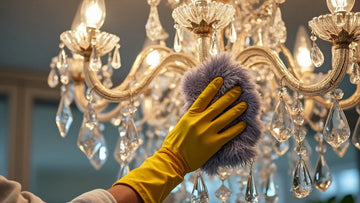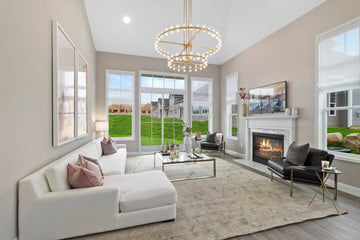Choosing the right light bulbs for your chandelier is essential for achieving the perfect lighting, enhancing the aesthetic appeal, and optimizing energy efficiency in your home. The type of light bulbs you select can significantly impact both the functionality and style of your chandelier, as well as your energy consumption. This guide will walk you through the key factors to consider when selecting bulbs for your chandelier, helping you make the best choice for your space.
Understanding Your Chandelier’s Requirements
Design and Style Considerations
Chandeliers come in a wide range of styles, from luxurious crystal designs to sleek modern fixtures. The light bulbs you choose should complement the design and enhance the overall aesthetic of the chandelier. For example, traditional chandeliers often pair well with candelabra-style bulbs, enhancing their classic, elegant look. On the other hand, more contemporary chandeliers may look best with globe-shaped or tubular bulbs. The shape and size of the bulb play an important role in maintaining the chandelier’s intended look.
Lighting Needs
It’s important to assess the lighting requirements of the room where the chandelier will be placed. Consider factors like the brightness (lumens) and the color temperature of the light. For example, a dining area may require bright, focused lighting, while a living room benefits from softer, ambient lighting. For warm and cozy environments, choose a color temperature of 2700K-3000K. If you need bright, clear light, such as in workspaces, opt for a cooler light (5000K-6500K).
Types of Light Bulbs for Chandeliers
1. Incandescent Bulbs
Incandescent bulbs are known for their warm, soft light, creating a welcoming and intimate atmosphere. They are ideal for chandeliers in living rooms or dining areas. However, they are not the most energy-efficient choice and have a shorter lifespan (about 1,000 hours). While they offer a classic look, they consume more power and need frequent replacement.
2. Halogen Bulbs
Halogen bulbs are a more energy-efficient version of incandescent bulbs, offering brighter and whiter light. These bulbs are commonly used in modern chandeliers to provide a crisp, clean light. They have a longer lifespan than incandescent bulbs, typically around 2,000 hours, but they still generate more heat and consume more energy than LED options.
3. LED Bulbs
LED bulbs are the most energy-efficient choice, offering a lifespan of up to 25,000 hours. They are available in a variety of color temperatures and can be dimmed for versatility. LED bulbs use much less power compared to incandescent and halogen bulbs, which leads to significant energy savings. Additionally, LEDs are cooler to the touch, reducing the risk of heat damage to delicate chandelier components. They are compatible with a variety of chandelier designs, both traditional and modern.
4. Compact Fluorescent Bulbs (CFLs)
CFLs offer a middle ground between incandescent and LED bulbs in terms of energy efficiency. They use less power than incandescent bulbs and have a longer lifespan (around 8,000 hours). However, they can take a few moments to reach full brightness and are not as ideal for chandeliers requiring instant lighting. CFLs also contain trace amounts of mercury, so they must be disposed of properly.
Choosing the Right Bulbs for Your Chandelier’s Features
Bulb Base Types
Ensure that the bulbs you choose are compatible with your chandelier’s socket. Common bulb bases include E12 (candelabra base), E14 (European base), and E26 (medium base). Using the correct bulb base ensures proper function and prevents potential electrical issues.
Bulb Shape and Size
The shape and size of the bulb should complement the chandelier’s design. For example, candelabra-shaped bulbs are often used in traditional chandeliers, while globe bulbs may be better suited for modern designs. Choosing the right size ensures that the bulbs fit properly and do not overpower the chandelier's structure.
Lighting Effects and Ambiance
Brightness and Dimming Capabilities
The brightness of a bulb is measured in lumens. To achieve the right lighting ambiance, consider the purpose of the room. For intimate areas like bedrooms or living rooms, a lower lumen output is ideal. Conversely, kitchens or dining rooms may need brighter lighting for visibility. Many modern chandeliers are compatible with dimmer switches, which allow you to adjust the light intensity according to different moods and occasions. Dimmable LED and halogen bulbs offer great flexibility for this purpose.
Color Temperature
The color temperature of the bulb impacts the mood of the room. Warmer light (2700K-3000K) is perfect for creating a cozy, relaxed atmosphere, ideal for spaces like bedrooms and living rooms. Neutral white light (3500K-4100K) provides balanced lighting suitable for workspaces like kitchens. Cooler light (5000K-6500K) is best for areas that require bright, task-oriented lighting, such as offices or bathrooms.
Energy Efficiency and Longevity
Energy Consumption
When choosing bulbs for your chandelier, it’s important to consider energy usage. LED bulbs consume significantly less power compared to incandescent and halogen bulbs, leading to substantial savings on your electricity bill. Although incandescent and halogen bulbs may be less expensive upfront, they are more costly in the long run due to their higher energy consumption.
Bulb Lifespan
The lifespan of light bulbs varies. LEDs last the longest, up to 25,000 hours or more. Halogen bulbs typically last around 2,000 hours, while incandescent bulbs may only last around 1,000 hours. CFLs provide a moderate lifespan of about 8,000 hours. Choosing longer-lasting bulbs can reduce the frequency of replacements and save you money over time.
Environmental and Health Considerations
Environmental Impact
LED bulbs are the most eco-friendly choice, as they are energy-efficient and have a long lifespan, reducing both energy consumption and waste. CFLs, while energy-efficient, contain mercury, which requires careful disposal. Incandescent and halogen bulbs have a greater environmental impact due to their higher energy consumption and shorter lifespans.
Health Considerations
Some bulbs, particularly CFLs, can emit blue light that may cause eye strain and disrupt sleep patterns. LED bulbs with high blue light content can also affect sleep, so it’s important to choose bulbs with a color temperature that aligns with your needs. Opting for warmer light in the evening can help reduce blue light exposure and improve sleep quality.
Practical Tips for Choosing Bulbs
Read Labels and Specifications
Always check the packaging of bulbs for key information, such as wattage, lumens (brightness), color temperature (Kelvin), and expected lifespan. Some bulbs are labeled as dimmable, which can be a useful feature for chandeliers with dimmer switches. Energy Star ratings can also guide you toward more energy-efficient options.
Test and Adjust
It’s a good idea to test different bulbs in your chandelier to see which one provides the best lighting for your space. Try various color temperatures and brightness levels to find the perfect match. You can always adjust based on the specific lighting needs of the room or the style of the chandelier.
Conclusion
Selecting the right light bulbs for your chandelier involves balancing aesthetics, energy efficiency, and lighting functionality. By understanding the different types of bulbs available, their benefits, and how they complement your chandelier's design, you can make an informed decision that enhances both the beauty and efficiency of your home. Whether you opt for LED, halogen, incandescent, or CFL bulbs, the right choice will ensure that your chandelier continues to shine brightly and beautifully for years to come.










